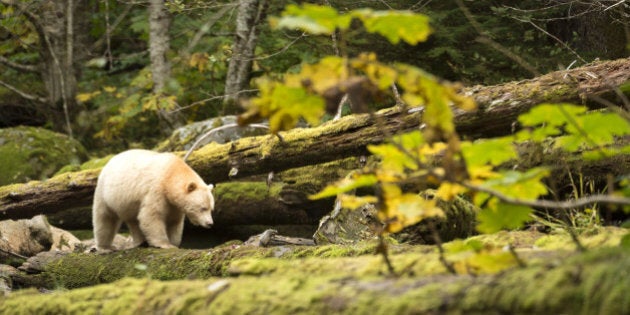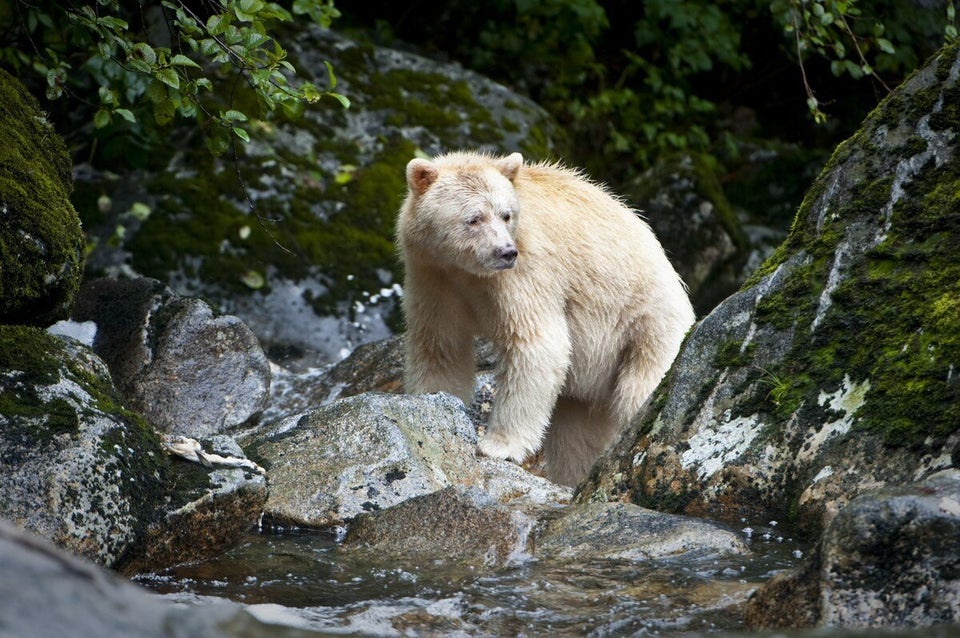
On the first day of February 2006, a landmark agreement that has been called "one of the most visionary forest conservation plans on Earth" was inked by First Nations elders, the provincial government and environmentalists.
Eighty five per cent of the Great Bear Rainforest -- at 3.1 million hectares, an area roughly twice the size of Vancouver Island -- is permanently off limits to logging. The other 15 per cent, about 500,000 hectares, will be available for forestry but governed by the "most stringent" standards in North America, according to environmental groups who were involved in the negotiations.
Those standards require the forestry companies to protect waterways, endangered species and respect First Nations cultural values. The deal, known as the Great Bear Rainforest Agreements, also strengthens First Nations oversight of their land and ends the commercial grizzly bear hunt in the region.
Just shy of the West Coast, the boreal forest changes radically: the skinny birch, larch and pine give way to the massive ancient douglas fir, red cedar and sitka spruce of the Great Bear Rainforest. The air becomes very humid, rain falls constantly and moss drapes the trees in long, bushy clumps. Some of the trees in the Great Bear are 1,500 years old -- mere saplings when the Roman Empire was collapsing.
The Great Bear, one of the world's largest temperate rainforests, is home to two extraordinary animal species that are unique in the world. The only coastal wolves that hunt salmon thrive off the Great Bear coast. The wolf packs, known as sea wolves, swim up to 10 kilometres among the islands off the coast hunting salmon and are the only population of wolves in the world to rely almost exclusively on the ocean and coastal landscape for food.
And that potent, iconic symbol of endangered wildlife, the spirit bear, clings to survival in the area. Spirit bears are a subspecies of black bears that are ghostly white from a genetic anomaly. The last 200 spirit bears on the planet live in and around the Great Bear, which stretches from the northern tip of Vancouver Island to the Alaskan Panhandle.
The ancient forest and the bears thrive in a graceful symbiosis; the bears carpet the forest floor with salmon carcasses, providing vital nutrition to the trees. In return, the muscular tree roots prevent soil erosion and landslides that would ruin the salmon streams that feed the bears.
The Great Bear Rainforest was formerly known, somewhat dryly, as the "central mid-coast timber supply area." Environmentalists renamed it after the iconic spirit bear when they began an innovative environmental campaign to persuade the world to stop buying products made from old-growth timber.
When European buyers began a boycott of B.C.'s old-growth forest products in 2001, gray-suited forestry execs sat down with scruffy environmentalists for a series of extraordinary meetings called the Joint Solutions Project at the Metropolitan Hotel in Vancouver and negotiated the Standstill Agreement.
The environmentalists stopped their ruinous campaigns and the logging companies suspended operations in more than 100 watersheds in the Great Bear region. In 2006, the stakeholders negotiated an agreement to designate 70 per cent of Great Bear old-growth forest off-limits to logging.
The First Nations, environmentalists and the loggers had been negotiating since the so-called Great Bear War in the Woods began in 1997, when environmental activists coined the name Great Bear Rainforest and started chaining themselves to logging equipment on remote islands. The Great Bear Rainforest was formally established in 2006 by then-premier Gordon Campbell, who earned international accolades for his efforts.
Some forestry companies, however, remained impervious to the spirit of reconciliation between stakeholders in the region. In spring 2013, residents of Sonora Island in the Great Bear found out that TimberWest Corp., which has long been known as the conservation laggard among the major loggers in the region, was preparing to legally clear cut some of the last old-growth stands on the island.
The TimberWest tenure is located in the least protected portion of the area and among the hardest hit by logging, with most of the rainforest already reduced to second-growth forest. The stands slated for logging included 700-year-old douglas fir and western red cedar.
Under TimberWest's interpretation of logging regulations, they claimed that the patches they planned to log are second growth, despite the obvious presence of giant trees and the community's carefully compiled records, which identify significant old-growth stands.
The tactics used in the Great Bear War in the Woods were pioneered by environmentalists on Vancouver Island in the early 1980s prompted by a rising tide of public concern about industrial logging in Clayoquot Sound on the west coast of Vancouver Island.
The culmination came in the huge protests, logging road blockades and mass arrests of the 1993 "Clayoquot Summer." Those protesters sparked a new form of environmental campaigning that reverberated around the globe and drew the Australian rock group Midnight Oil to play a concert at the protesters' camp, with lead singer Peter Garrett declaring: "This is no way to look after the land."
When I was working on my latest book, There Is No Planet B: Promise And Peril On Our Warming World, I showed my 10-year-old daughter, Grace, photos of the spirit bear and explained how their habitat was threatened by logging.
I promised to take her to the Great Bear some day and told her we'd better hurry because the spirit bears could be gone soon. When I told her about the new agreement, we shared a fist bump because we knew we had all the time in the world.
Follow HuffPost Canada Blogs on Facebook
MORE ON HUFFPOST:
